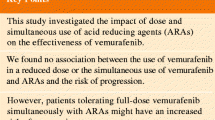Abstract
Introduction
A combined therapy MEK inhibitor, Cobimetinib (CB) and BRAF inhibitor, Vemurafenib (VMF), results in an improvement in progression-free survival among patients with BRAF V600-mutated metastatic melanoma. VMF skin adverse effects attributed to ERK paradoxical activation are decreased by the adjunction of CB. The aim of this study was to determine if this combination also improved the renal side effects of VMF.
Patients and methods
To investigate the incidence of acute kidney injury (AKI), we conducted a retrospective observational monocentric study in Lyon Sud University Hospital in France. We included 38 patients with metastatic BRAF-mutated melanomas treated by VMF and CB between March 2015 and June 2016. According to the NCI-CTCAE classification, AKI was defined as an increase in serum creatinine exceeding the baseline concentration by 1.5-fold. Serum creatinine was measured before treatment, then on a monthly basis during treatment, and 1 month after treatment discontinuation. Patients were divided into two main groups: AKI-positive (AKI+) and AKI-negative (AKI−), and further subdivided into three groups according to AKI severity (stage 1–5).
Results
Of 38 patients, 29 (76%) were AKI−, and all 9 AKI+ patients (24%) were diagnosed within the first trimester of treatment. Three-quarters of AKI (n = 7, 77%) had stage 1 AKI and the remaining 23% stage 2 AKI. Pre-treatment renal function was significantly better in AKI+ group: 105 vs. 80 ml/min/1.73m² AKI−, p = 0.009. Compared to previous results, the AKI incidence under the combined VMF–CB vs. VMF monotherapy was reduced by 60%.
Conclusion
We reported a reduced incidence and severity of nephrotoxicity of the association inhibitors of BRAF and MEK compared to a BRAF inhibitor monotherapy.

Similar content being viewed by others
References
Chapman PB, Hauschild A, Robert C et al (2011) Improved Survival with Vemurafenib in Melanoma with BRAF V600E Mutation. N Engl J Med 364(26):2507–2516
McArthur GA, Chapman PB, Robert C et al (2014) Safety and efficacy of Vemurafenib in BRAF V600E and BRAF V600K mutation-positive melanoma (BRIM-3): extended follow-up of a phase 3, randomised, open-label study. Lancet Oncol 15(3):323–332
Teuma C, Perier-Muzet M, Pelletier S et al (2016) New insights into renal toxicity of the B-RAF inhibitor, Vemurafenib, in patients with metastatic melanoma. Cancer Chemother Pharmacol 78(2):419–426
Wanchoo R, Jhaveri KD, Deray G, Launay-Vacher V (2016) Renal effects of BRAF inhibitors: a systematic review by the Cancer and the Kidney International Network. Clin. Kidney J 9(2):245–251
Hauschild A, Grob J-J, Demidov LV et al (2012) Dabrafenib in BRAF-mutated metastatic melanoma: a multicentre, open-label, phase 3 randomised controlled trial. Lancet Lond. Engl 380(9839):358–365
Tran KA, Cheng MY, Mitra A et al (2016) MEK inhibitors and their potential in the treatment of advanced melanoma: the advantages of combination therapy. Drug Des Dev Ther 10:43–52
Shi H, Hugo W, Kong X et al (2014) Acquired resistance and clonal evolution in melanoma during BRAF inhibitor therapy. Cancer Discov 4(1):80–93
Rizos H, Menzies AM, Pupo GM et al (2014) BRAF inhibitor resistance mechanisms in metastatic melanoma: spectrum and clinical impact. Clin Cancer Res 20(7):1965–1977
Larkin J, Ascierto PA, Dréno B et al (2014) Combined Vemurafenib and Cobimetinib in BRAF-mutated melanoma. N Engl J Med 371(20):1867–1876
Robert C, Karaszewska B, Schachter J et al (2015) Improved overall survival in melanoma with combined dabrafenib and trametinib. N Engl J Med 372(1):30–39
Levey AS, Stevens LA, Schmid CH et al (2009) A new equation to estimate Glomerular filtration rate. Ann Intern Med 150(9):604–612
Andrassy KM. Comments on (2013) KDIGO 2012 clinical practice guideline for the evaluation and management of chronic kidney disease. Kidney Int 84(3):622–623
Common Terminology Criteria for Adverse Events (CTCAE)-CTCAE_4.03_2010-06. https://www.eortc.be/services/doc/ctc/CTCAE_4.03_2010-06-14_QuickReference_5x7.pdf
Keating GM (2016) Cobimetinib plus Vemurafenib: a review in BRAF (V600) mutation-positive unresectable or metastatic melanoma. Drugs 76(5):605–615
Jansen YJ, Janssens P, Hoorens A et al (2015) Granulomatous nephritis and dermatitis in a patient with BRAF V600E mutant metastatic melanoma treated with dabrafenib and trametinib. Melanoma Res 25:550–554
Su F, Viros A, Milagre C et al (2012) RAS mutations in cutaneous squamous-cell carcinomas in patients treated with BRAF inhibitors. N Engl J Med 366(3):207–215
Pat B, Yang T, Kong C et al (2005) Activation of ERK in renal fibrosis after unilateral ureteral obstruction: modulation by antioxidants. Kidney Int 67(3):931–943
Fukatsu A, Matsuo S, Tamai H et al (1991) Distribution of interleukin-6 in normal and diseased human kidney. Lab Investig J Tech Methods Pathol 65(1):61–66
Papayianni A (1996) Cytokines, growth factors, and other inflammatory mediators in glomerulonephritis. Ren Fail 18(5):725–740
Jo SK (2005) MEK inhibitor, U0126, attenuates cisplatin-induced renal injury by decreasing inflammation and apoptosis. Kidney Int 67(2):458–466
Hurabielle C, Pillebout E, Stehlé T et al (2016) Mechanisms underpinning increased plasma creatinine levels in patients receiving Vemurafenib for advanced melanoma. PLoS One 11(3):e0149873
Flaherty KT, Infante JR, Daud A et al (2012) Combined BRAF and MEK inhibition in melanoma with BRAF V600 mutations. N Engl J Med 367:1694–1703
Jhaveri KD, Sakhiya V, Fishbane S (2015) Nephrotoxicity of the BRAF Inhibitors Vemurafenib and Dabrafenib. JAMA Oncol. doi:10.1001/jamaoncol.2015.1713
Acknowledgements
The authors would like to thank the members of Dermatology Department of the CHU Lyon Sud, Mathilde Nouvier MD, Pierre Trolliet and Louis De Laforcade MD from the Nephrology Department of CHU Lyon Sud, Lyon, France for the help with patient recruitment.
Author information
Authors and Affiliations
Corresponding author
Ethics declarations
Conflict of interest
The authors declare that they have no conflict of interest.
Ethical standards
All procedures in our study involving human participants were in accordance with the ethical standards with the 1964 Helsinki declaration and its later amendments or comparable ethical standards.
Animal rights
This article does not contain any studies with animals performed by any of the authors.
Rights and permissions
About this article
Cite this article
Teuma, C., Pelletier, S., Amini-Adl, M. et al. Adjunction of a MEK inhibitor to Vemurafenib in the treatment of metastatic melanoma results in a 60% reduction of acute kidney injury. Cancer Chemother Pharmacol 79, 1043–1049 (2017). https://doi.org/10.1007/s00280-017-3300-2
Received:
Accepted:
Published:
Issue Date:
DOI: https://doi.org/10.1007/s00280-017-3300-2




